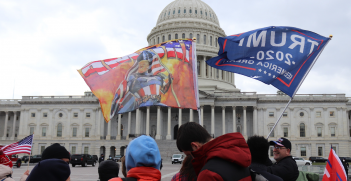COP23 and the Shadow Over the Paris Agreement

COP23, the UN’s climate change conference, starts this week and, beyond a discussion of pressing climate dangers, many will be watching how America will act after President Trump’s call for US withdrawal.
For the first time ever, a small island state, Fiji, is hosting the annual UN climate negotiations, running 6-17 November in Bonn, Germany. To concentrate the negotiators’ minds on the collective mission, the Fijian presidency has installed a traditional double-hulled Fijian canoe, called a ‘druha’, in Bonn’s World Conference Center to symbolise that all parties are ultimately in the same canoe. But, as everyone knows, there is one very significant party that is rocking the vessel and threatening to jump out.
So why are the parties meeting again given that the Paris Agreement 2015 is now signed and sealed? The primary purpose of the Bonn negotiations, known as COP23 (the 23rd Conference of the Parties to the UN Framework Convention on Climate Change, 1992), is to develop the detailed rule book on the implementation of the Paris Agreement. This rule book is crucial to the success of the agreement, since it will determine the robustness of the mitigation pledge and review system. This includes the degree of transparency of the parties’ ‘nationally determined contributions’ (NDCs) and how the process of five-yearly cycles of stocktaking, reviewing progress and revising the NDCs will be structured.
At Paris in 2015, the parties gave themselves three years to complete the rule book, so that it would be ready for adoption at COP24 in Poland in 2018. COP24 will be a crucial milestone in the post-Paris negotiations since it will include the first global stocktake to assess collective progress towards peaking and reducing global emissions as rapidly as possible and reaching net zero emissions in the second half of this century.
What, then, is the ‘Trump effect’ on this round of negotiations?
President Donald Trump announced in June this year that the US intends to withdraw from the Paris Agreement. However, under the agreement’s provisions, any formal notice of withdrawal will take four years to take effect, which means the US cannot officially withdraw before the next presidential election.
The US has since announced it will stay in if it can negotiate more favourable terms. However, the Paris Agreement is not up for renegotiation. It entered into legal force on 4 November 2016, only days before Donald Trump’s presidential victory on 9 November. It is designed to be a durable and flexible agreement that provides a framework for parties to enhance the ambition of their mitigation commitments in regular five-yearly cycles.
This leaves two options for the Trump administration. They are not mutually exclusive. The first is to renegotiate the US’ NDC, which was pledged by the Obama administration. This would clearly be contrary to the spirit, if not the letter, of the Paris Agreement, which requires each successive NDC to be more ambitious than the previous one, and allows and encourages parties to upgrade their NDC within the cycles. But there is nothing in the agreement that would prevent a party from downgrading their first NDC, although it is clearly not a precedent that the parties wish to encourage. If it turns out to be the price of keeping the US in the game, it could be a very high price if other parties decided to follow suit.
The most devastating effect of Trump’s dismissal of the Paris Agreement is his decision to reverse the Obama administration’s commitment to climate finance, including a commitment of USD$1 billion (AUD$1.3 billion) to the Green Climate Fund, which is the largest single commitment of any party. However, only one third of this had been handed over, and Trump’s refusal to pay the balance will be a major blow to developing countries, which are dependent on climate finance to pursue not only mitigation, but also adaptation to climate change. Indeed, some developing countries have made their NDCs conditional on receiving adequate finance, so if the US can be allowed to downgrade its NDC, then why can’t they, given that their clearly stipulated conditions are now less likely to be met?
The second option is for the Trump administration to seek a more flexible and less rigorous Paris rule book. The US has already made it clear that it will attend the Bonn negotiations to protect its interests and keep all its policy options open. The US negotiating team will be led by Under Secretary of State for Political Affairs, Thomas Shannon. Shannon, a respected diplomat, has called climate change “one of the world’s greatest challenges” in a speech given in Bangladesh. However, as a career diplomat, his job is to follow his instructions and it remains unclear whether the US negotiating team will play a blocking or destructive game, and if it does, how the parties will respond to the US focussing on ‘America First’.
The Trump administration is therefore in an odd position in making it clear to the world that it does not like the Paris Agreement and wishes to withdraw, while also using its prerogative to exercise its rights to shape the negotiations in its favour. It is effectively saying ‘I want my cake and I want to eat it too’. Given the enormous effort that has gone into producing the Paris Agreement and the importance of maintaining momentum for it to succeed, the US is clearly a major spoiler. The US was frozen out and isolated at the G20 summit in July this year and it is possible that it may find itself in a similar experience in Bonn.
However, the US negotiating team has traditionally insisted on strong transparency rules to ensure that mitigation commitments are measurable, reportable and verifiable. These are unlikely to be matters that would interest Trump, given their technical nature, so it’s possible that he will leave these matters to the State Department and the US may not veer too much off its traditional course.
Meanwhile, a very large and unofficial delegation of climate leaders from the US will be attending the Bonn negotiations to demonstrate their commitment to the Paris Agreement as part of the ‘We Are Still In’ movement. More than 2,500 leaders from states, cities, businesses, universities, churches and NGOs have signed the ‘We are Still In’ declaration since it was released in June. These leaders represent a significant cross-section of American society and represent more than 127 million Americans spanning all states. This unofficial COP23 US delegation has established a pavilion, the US Climate Action Center, with a rolling roster of events to showcase climate action in the US. Thanks to these efforts, a future, more enlightened president will have something to build on.
Robyn Eckersley is a professor of political Science in the School of Social and Political Sciences at the University of Melbourne.
This article is published under a Creative Commons Licence and may be republished with attribution.





